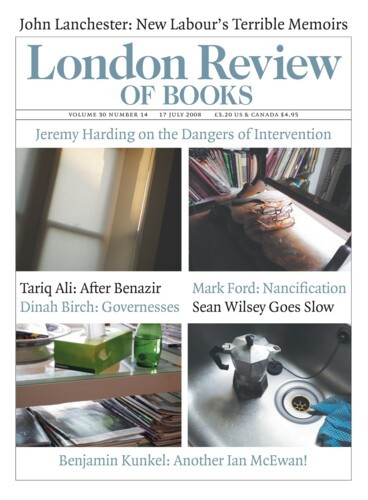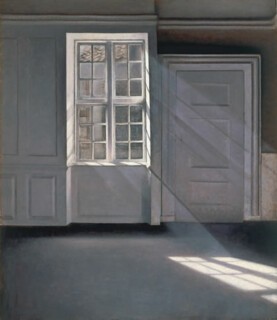The pictures in Radical Light (National Gallery until 7 September) have a technique in common, Divisionism, but not a lot else. The aim was to achieve luminosity by building up tones with thread-like strokes of pure colour – Pointillism with lines, not spots. The eye would create colours, as it creates them from the black, cyan, magenta and yellow halftone dots of printed illustrations. The tints produced would be cleaner than those mixed on the palette. Treatises like Chevreul’s De la loi du contraste simultané des couleurs and Rood’s Modern Chromatics encouraged the Divisionists in their experiments. Angelo Morbelli’s In the Rice Fields is a good example of what came of them. A row of young women, skirts hitched up, stand knee-deep in a paddy field. Clothes, skin, the leaves of rice, water and sky, are done in tiny strokes so glossy that the paint glitters – you might think specks of glass had been added to it. Luminosity is indeed achieved, but the price, here and elsewhere, is paid in terms of blunted forms and a limiting uniformity of touch.
Divisionism, like Pointillism, continued the Impressionist campaign with different weapons, but while the Pointillists were still largely painters of landscape and modern life, the Divisionists expanded into (or sustained or reverted to) larger subject matter as well. So while the exhibition has a group of pictures of landscape and rural life – Longoni’s Glacier and Boccioni’s Lombard Countryside, for example – there are also Symbolist pieces like Segantini’s Vanitas, in which a naked girl looks into a pool on the edge of an Alpine meadow that is occupied by a particularly loathsome worm and Previati’s Motherhood, in which a nursing mother is surrounded by kneeling angels. In Morbelli’s The Christmas of Those Left Behind five men sit apart from each other on long benches that fill a room in an old people’s home in Milan. Sunlight from an unseen window strikes one of them, who looks down, and another who leans forward with his head on his hands.
In these Divisionist paintings strokes – some tiny, some as coarse as grated carrot – follow curves, as though the paint had been combed or raked. A Divisionist way with bright light is used to record things as disparate as the glow behind the mother, the strong highlights on the faces of the old men, the glitter of schist-like striations in Alpine rocks, and the glistening highlights on meadow grass.
The Futurists developed a brand of Modernism using the same tools. In their Divisionist pictures dashes are set swirling to record the movement, energy, light and machinery of the modern city. Gathered and directed like iron filings by a magnet, they follow the mane of a plunging horse in Boccioni’s The City Rises, lightning zigzagging from dark clouds in Russolo’s Lightning, the glitter of a crowded city at night in Carrà’s Leaving the Theatre. The excitement these Futurist pictures aroused when they were new (nearly all were painted between 1909 and 1911) can still be felt: they have worn well. Although they come at the end of the Divisionist story, in the exhibition they are hung in the first room – maybe the curators wanted you to keep them in mind. The rest of the exhibition has more than its fair share of silly, sentimental, even inept, pictures.
Eleven of those now on show at the National Gallery were among the thirty or so included in the Italian section of the Royal Academy’s 1979 Post-Impressionism exhibition. What one learned from the work caught in that wide trawl – like Radical Light it covered the period from around 1880 to about 1910 – was that while both content and style date a picture, content is much more likely to go sour on you. The notion that painting had by this time become its own subject – that inventive representations which make the ordinary world extraordinary are its proper end – seemed good sense if you kept in mind only Fauve landscapes, Cubist still lifes, Pointillist riverbanks, and the Impressionist cities, garden parties and women at work that preceded them. Why do Symbolist dreams, allegorical fantasies, calls to action and social protests like those that make up much of Radical Light tend to fall out of the frame? One answer may be that rhetorical subjects have short lifespans. No one likes the sense of being told what to feel. Longoni’s Alone! shows a young woman, her face buried in her arms beside a lily-covered coffin. Longoni has made grief weakly pretty. Morbelli’s old men, on the other hand, seem to announce a documentary truth: ‘This is how things are, what you think about it is up to you.’ But not entirely up to you. Titles underline intentions: The Christmas of Those Left Behind gives the image a narrative twist.
Three years before Morbelli painted that picture in Milan, Vilhelm Hammershøi, in Copenhagen, painted a picture called Woman Reading in Sunlight, Strandgade 30. The room where she sits, with her back to you, was in Hammershøi’s apartment. The sun shines through the fabric of looped-back curtains. The bright patches of light on the floor are shaped by the window she faces. These more or less contemporary pictures of subdued people and sudden sunlight are both on show in London – Hammershøi’s painting is in a show of his work at the Royal Academy, also until 7 September. They have things in common – the drama of bright patches of light, the way emotional force gathers around figures isolated in simple, even frugal surroundings – but Hammershøi does not intrude. As with his other pictures of rooms, sparsely furnished and empty or occupied by a single figure, usually a woman, often with her back to you, meaning arises from the sense that the moment they describe is in the present. The curtain has just gone up on an empty stage, or a stage on which an actor pauses. We wait, knowing that the force of the picture comes from what is not explained, from the sense that we are onlookers who may wait and watch but who are not told stories about what we see.
A broad definition of Post-Impressionism includes other painters who treat the viewer in this way – Gwen John, for example. Hammershøi, who looks back to Vermeer (he made his own version of a Vermeer letter-reader) and to Caspar David Friedrich’s woman at a window, painted in subdued greys, blacks, browns that owe something to Whistler. Gwen John, who was taught by Whistler, put on paint in calculated patches; the chalkiness of her paint and the thinness of Hammershøi’s match the frugality of the rooms and simple clothes they show to the facture of their pictures.
There are a number of painters of quiet rooms (photographs suggest that Hammershøi’s apartment was not as spartan as the paintings make it seem) whose work is particularly well loved by people who don’t care all that much about art. You can add Andrew Wyeth’s chilly New England clapboard houses and Edward Hopper’s brownstones to the list: like domestic novels these paintings can be attractive because they seem to be deep as well as quiet. They attract by their very lack of excitement. It is my guess that word of mouth will ensure that Vilhelm Hammershøi: The Poetry of Silence stays busy.
Send Letters To:
The Editor
London Review of Books,
28 Little Russell Street
London, WC1A 2HN
letters@lrb.co.uk
Please include name, address, and a telephone number.


